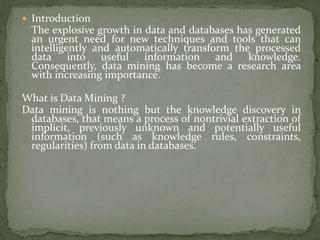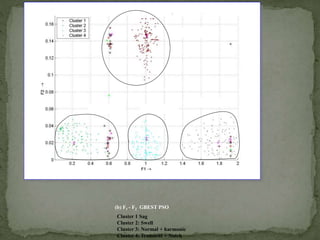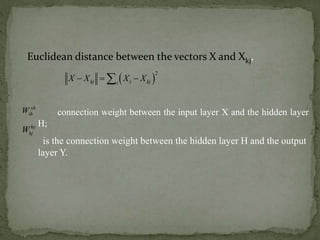Mining of time series data base using fuzzy neural information systems
- 2. Introduction The explosive growth in data and databases has generated an urgent need for new techniques and tools that can intelligently and automatically transform the processed data into useful information and knowledge. Consequently, data mining has become a research area with increasing importance. What is Data Mining ? Data mining is nothing but the knowledge discovery in databases, that means a process of nontrivial extraction of implicit, previously unknown and potentially useful information (such as knowledge rules, constraints, regularities) from data in databases.
- 3. A data-mining algorithm constitutes a model, a preference criterion, and a search algorithm. The more common model functions in data mining include classification, clustering, rule generation and knowledge discovery What is Knowledge Discovery in Databases (KDD)? Extraction of meaningful information from a large database.
- 4. Data Selection Data Compression Data formatting Data Mining KDD Raw voltage Data samples Overall KDD block diagram
- 5. What is time series data mining ? A time series data is nothing but the data varies with time. Two types of time series data: 1. Periodic data 2. Non-stationary data Examples of Non-stationary data: Seismic signal Power signal Speech signal Radar signal Biomedical signal and fluctuating data occurring in business, financial markets including stocks, etc
- 6. Existing Research work ? Objective of the thesis : In this thesis is focused on the application of data mining concepts to power network signal disturbance time series, the approach is a general one and can be applied to any time varying and non- stationary data that arises in different fields of science and engineering.
- 7. Data Mining Block diagram Figure to be inserted from published paper
- 8. Thus the main objective of the thesis is summarized as 1. Feature vector selection in data mining using advanced signal processing techniques using Wavelet transform and S-transform. 2. Developing a S-Transform based new hybrid K- means and Particle Swarm Optimizer for data clustering and classification in time series data mining. Developing new Neural and Neuro-Fuzzy classifiers for classification in data mining. * Wavelet transform * S-Transform
- 9. Fourier Transform The Fourier Transform is one of the oldest and most powerful tools in signal processing. This transform maps the signal in time domain to a frequency domain. The Fourier Transform of a signal is given as: 2 ( ) ( ) i ft Y f y t e dt 2 ( ) ( ) i ft y t Y f e df
- 10. Discrete version of FT is DFT of a time series of length N is 21 0 1 [ ] i nkTN NT k n Y y kT e NT N where T is the sampling interval. Short Time Fourier Transform (STFT) 2 , ( ) ( ) i ft STFT f y t w t e dt
- 11. Wavelet Transform and Multi-resolution analysis * ,( , ) ( ) ( )a bW a b y t t dt where is any square integrable function, a is the scaling parameter, b is the translation parameter and is the dilation and translation of the mother wavelet. , ( )a b t ( )y t , 1 ( )a b t b t aa
- 12. Phase Corrected Wavelet: S-Transform 2 ( , ) ( ) , i ft S f y t g t f e where the Gaussian modulation function g( , f) is given by 2 2 2 ( , ) 2 t f g f e with the spread parameter inversely proportional to the frequency 1 f
- 13. The final expression becomes 2 2 ( ) 22 ( , ) ( ) 2 t f i ftf S f y t e e dt To increase the frequency resolution, the spread of the Gaussian window is written as f and the generalized S-Transform is obtained as 2 2 2 ( ) 22 ( , ) ( ) 2 t f i ftf S f y t e e dt
- 14. Implementation of S-Transform (ST) The computation of the S-Transform is efficiently implemented using the convolution theorem and FFT. The following steps are used for the computation of S-Transform: 1. Compute the DFT of the signal y(k) using FFT software routine and shift spectrum Y[m] to Y[m+n]. 2. Compute the Gaussian window function for the required frequency n. 3. Compute the inverse Fourier Transform of the product of DFT and Gaussian window function to give the ST matrix. 2 2 2 2 exp(-2π β m /n )
- 15. Comparison between DWT and S-Transform for Analysis of Time Series Events (a)Oscillatory transient (b) S-Transform output of oscillatory transient (a) (b)
- 16. (a) Oscillatory transient (b) Level 4 detail coefficients (c) Level 3 detail coefficients (d) Level 2 detail coefficients (e) Level 1 detail coefficients
- 17. (a) Swell (b) S-Transform output of voltage swell
- 18. (a) Swell (b) Level 4 detail coefficients (c) Level 3 detail coefficients (d) Level 2 detail coefficients (e) Level 1 detail coefficients
- 19. Feature Extraction Disturbances F1 F2 F3 F4 F5 Normal 1.002 Sag (60%) 0.593 0.053 .031 .0312 50.0 Swell (50%) 1.50 0.012 9 .076 .015 50 Momentary Interruption (MI) (5%) 0.0724 0.035 .019 .0350 50 Harmonics (0% 3rd + 10% 5th) 1.0 0.033 9 .0556 .141 50 Sag with Harmonic (60%) 0.601 .0228 .0408 .1139 50 Swell with Harmonic (50%) 1.5 .0219 .079 .1155 50 Flicker (5 Hz, 4%) 0.987 .0168 .026 0.0186 55
- 20. Sag (60%) .591 .022 .039 .027 50 Swell (50%) 1.503 .012 .076 .029 50 Momentary Interruption (MI) .070 .0387 .0323 .044 50 Harmonics 1.032 .050 .064 0.25 50 Sag with Harmonic (60%) 0.601 .0228 .0408 0.1139 50 Swell with Harmonic (50%) 1.50 .0219 .079 .1155 50 Flicker (4%, 5 Hz) .998 .0209 .027 0.1159 55 Notch + harmonics .940 .1275 .0531 0.198 50 Spike + harmonics 1.072 .141 .066 .204 50 Transient (low frequency) 1.021 0.1473 .0148 .0566 440
- 21. Table- 3: Effects of Window parameter α Steady state variations Transient variations Factor F1 F2 F1 F2 0.4 0.602 0.0427 0.9877 0.1654 0.6 0.610 0.0236 0.9898 0.1650 0.8 0.621 0.01735 0.9911 0.1647 1 0.633 0.0145 0.9923 0.1623 1.2 0.645 0.0126 0.9927 0.1600
- 22. Conclusion
- 23. Introduction The goal of clustering is to identify the structure of an unlabeled data set by objectively organizing data into homogenous groups where the within-group-object similarity is minimized and between the groups object- dissimilarity is maximized. The clustering aims at identifying and extracting significant groups in underlying data.
- 24. Time series clustering using feature based approach. Feature Extraction (ST or WT) Clustering algorithm Time series ClustersFeatures Model based Clustering Discretization Modeling Modeling Clustering Model parameters Cluster Centres Coefficients of Residualsraw materials
- 25. K-Means Clustering },...,2,1(},,...,2,1{, KjNizxd ji ji Cx i j j Kjx N z ,...,2,1, 1 where zj is the jth cluster center. The necessary condition of the minimum J is where Nj is the number of points belonging to cluster Cj.
- 26. PSO (Particle Swarm Optimization) The aim of the PSO is to find the particle position that results in the best evaluation of a given fitness (objective) function. Each particle represents a position in Nd dimensional space, and is “flown” through this multi- dimensional search space, adjusting its position towards both. the particle’s best position found thus far, and the best position in the neighborhood of that particle. Each particle i maintains the following information: xi : The current position of the particle; vi : The current velocity of the particle ; yi : The personal best position of the particle.
- 27. , , 1 1, , 2 2, , ˆ( 1) ( ) ( ) ( ( )) ( )( ( ) ( ))i k i k k i k k k i kv t wv t c r t y x t c r t y t x t ( 1) ( ) ( 1)i i ix t x t v t where w is the inertia weight c1 and c2 are the acceleration constants, , and k=1,…,Nd.1, ( )kr t 2, ( ) ~ (0,1),jr t U PSO Clustering In the context of clustering, a single particle represents the Nc cluster centroid vectors. That is, each particle xi is constructed as follows: 1 1( ,..., ,..., )ci i j iNx m m m where mi1 refers to the j-th cluster centroid vector of the i-th particle in cluster Cij. The fitness of particles is easily measured as the quantization error,
- 28. 1 ( , ) /p ij Nc j Z C p j ij e c d z m C J N where is the number of data vectors belonging to cluster Cij.ijC gbest PSO Cluster Algorithm 1. Initialize each particle to contain Nc randomly selected cluster centroids. Calculate the Euclidean distance d(zp , mij) to all cluster centroids Cij. Using the above notation, the standard K-means algorithm is summarized as 1. Randomly initialize the Nc cluster centroid vectors.
- 29. 2. Repeat (a) For each data vector, assign the vector to the class with the closest centroid vector, where the distance to the centroid is determined using (b) Recalculate the cluster centroid vectors, using 1 p j j p Z Cj m z n until a stopping criterion is satisfied. (ii) Assign zp to cluster Cij such that (i) 1,...,( , ) min ( , )cp ij c N p icd z m d z m (1) (2)
- 30. (iii) Calculate the global best and local best positions c) Update the global best and local best positions d) Update the cluster centroids using equations (1) and (2). where tmax is the maximum number of iterations. Hybrid PSO Algorithm It is based on the passive congregation and a kind of coordinated aggregation observed in the swarms known as GPAC-PSO and modifying it further to yield GPAC-Adaptive PSO or simply to be known as GPAC-APSO. The swarms of the enhanced GPAC is manipulated by the velocity update 1 1 2 2 3 3( 1) . ( ). ( ) . .( ( ) . .( ( )) . .( ( ))i i i i k i r iv t k w t v t c rand P S t c rand P S t c rand P S t
- 31. where i = 1, 2,…, N; c1, c2, and c3 are the cognitive, social, and passive congregation parameters, respectively; rand1, rand2, and rand3 are random numbers uniformly distributed within [0,1]; Pi is the best previous position of the ith particle; Pk is either the global best position ever attained among all particles in the case of enhanced GPAC and Pr is the position of passive congregator (position of a randomly chosen particle-r).
- 32. the quantization error the intra-cluster distances, i.e. the distance between data vectors within a cluster, where the objective is to minimize the intra-cluster distances; the inter-cluster distances, i.e. the distance between the centroids of the clusters, where the objective is to maximize the distance between clusters. w=0.72 and c1=c2=1.49 to ensure good convergence.
- 33. (a) F1- F2 K-Means PSO Cluster-4 Cluster-3 Cluster-1 Cluster-2 HYBRID PSO OUTPUT : Cluster 1 Sag Cluster 2: Swell Cluster 3: Normal + harmonic Cluster 4: Transient + Notch
- 34. GBEST PSO OUTPUT (b) F1 - F2 GBEST PSO Cluster-1 Cluster-4 Cluster-3Cluster-2 GBEST PSO OUTPUT Cluster 1 Sag Cluster 2: Swell Cluster 3: Normal + harmonic Cluster 4: Transient + Notch
- 35. (c) F1- F2 GPAC APSO GPAC APSO OUTPUT Cluster-4 Cluster-1 Cluster-3 Cluster-2 Cluster 1 Sag Cluster 2: Swell Cluster 3: Normal + harmonic Cluster 4: Transient + Notch
- 36. F1 - F2 Fitness Plots GPAC APSO PSO K-Means GBEST PSOGPAC APSO K-Means PSO GPAC-APSO GBEST PSO
- 37. The proposed method is very efficient and simple to implement for clustering analysis when the number of clusters is known a priori. The modified GPAC-PSO known as GPAC-APSO is found to be more efficient and has a quick convergence property in comparison to other PSO variants.
- 38. The next step in this research is to transform the visually distinguishable patterns to feature vectors that can be used by classifiers such as neural networks to automatically classify the disturbances.
- 39. * In order to improve the classification accuracy a novel neural architecture comprising hybrid combinations of the radial basis function neural network and a functional link network that provides a more robust pattern recognizer for non-stationary time series data is undertaken for detailed study.
- 40. Signal S-transform Feature extraction Neural Network Display recognized patterns PO ST PR OC ESS I NG A Neural network architecture is used to test the efficacy of the proposed method.
- 41. 2 1 Q j ij xdE )()1( kEk w where Q is the number of training samples and the weights are updated as where wE is the gradient with respect to weight, and is the momentum constant, and is the learning rate.
- 42. It consists of a radial basis layer and a competitive layer. FIGURE 4.3 TO INSERT
- 43. where i number of input layers; h number of hidden layers j number of output layers; k number of training examples; Nk number of classification (clusters); σ smoothing parameters (standard deviation), 0.1< σ <1 X input vector; The algorithm of the inference output vector Y in the PNN is as follows: 1 . and ,hy hy j hj h j hj h hj net W H N W N max( ) then 1, else 0j k j j k net net Y Y If
- 44. Euclidean distance between the vectors X and Xkj, 2 kj i kji X X X X connection weight between the input layer X and the hidden layer H; is the connection weight between the hidden layer H and the output layer Y. xh ihW hy hjW
- 45. We use RBFs with the random vector functional link nets (RVFLNs) to obtain the powerful radial basis functional link nets (RBFLNs). As RBFNN represents a nonlinear model while the RBFLN includes that nonlinear model as well as a linear model (the direct lines from the input to output nodes) so that the linear parts of a mapping do not need to be approximated by the nonlinear model.
- 46. Radial Basis Functional Link Net (RBFLN)
- 47. For an input vector , the output of th output node produced by an RBF is given by 11 11 )( 1 1 )( 2 )()()( m n noj m i i ctx ij m i m n nojiijj txwewtxwtwto i where is the center of the ‘i’ th hidden node, is the width of the ‘i’th center, and is the total number of hidden nodes. If output of the hidden neurons, by vector notation ))t(....,),........t(),t(( tot 21 and weight vector for the hidden RBF units
- 48. )w,......,w,w(w mjj2j1j and the weight vector for the linear units )w,.......,w,w(w mjj2j1j RBFLN output can be written as j T jj wwo The sets of centers are trained with K-means clustering approach, where the centers are initially defined as the first training inputs that correspond to a specific class . The Centroid vector is given by )c(x.,),........c(x),c(x)i(C mcc 210 c
- 49. At each iteration , following a new input is presented, the distance for each of the centers is denoted by i )(ix )i(jj c)i(x)i( 1 cm...,,.........2,1j where The kth center is updated by the following equation: )i()i(C)i(C kkk 1 k is chosen in such a way that it minimizes )(ij )i(arg(min(k jThus and is the learning rate.
- 50. The width associated with the k th center is adjusted as 2 1 1 aN j jkk )i(C)i(C N )i( Where N is the number of hidden neurons. Wavelet based Neural Classification Schemes Method-1 (WT-1) was implemented using the thirteen level coiflet 5-wavelet decomposition. The de-noising step in Method-2(WT-2) was omitted to test its effectiveness in noise. A hybrid DFT-DWT fuzzy expert system approach known as Method-3 (WT-3) is also considered in this paper for feature extraction and disturbance pattern classification.
- 52. Block diagram of classification algorithm
- 53. The important features obtained from the Fourier (DFT) and wavelet analysis (DWT) for the non-stationary disturbance time series data are listed as follows: 1 Fundamental and harmonic components obtained from the Discrete Fourier Transform of the time series signal data samples. 2. The phase angle shift of the disturbance time series with respect to normal waveform Ln. 3. Number of peaks of the wavelet coefficients (Nn). 4. Energy of the wavelet coefficients (Ewn). 5. Oscillation number of missing voltage time series data.
- 54. The extracted features are then used with different types of neural classifiers such as multilayered perceptron network, probabilistic neural network, and proposed radial basis functional link network for pattern classification, data mining and subsequent knowledge discovery.
- 55. MLP Pure 30dB Method WT-1 WT-2 ST WT-1 WT-2 ST Oscillatory transient 95% 95% 90% 30% 90% 95% Impulsive transient 100% 70% 95% 100% 65% 85% Multiple notch 100% 85% 100% 90% 85% 100% Voltage swell 100% 100% 100% 55% 95% 100% Voltage sag 90% 80% 80% 60% 85% 96% Interruption 100% 90% 100% 100% 95% 100% Harmonics 100% 85% 90% 15% 80% 85% Swell + harmonics 100% 95% 100% 60% 95% 100% Sag +harmonics 100% 80% 100% 25% 80% 100% Average 98.33% 86.67% 95% 59.44% 85.56% %
- 56. RBFLN Pure 30dB Method WT-1 WT-2 ST WT-1 WT-2 ST Oscillatory transient 95% 95% 80% 45% 30% 90% Impulsive transient 100% 75% 100% 95% 65% 70% Multiple notch 85% 85% 90% 85% 85% 95% Voltage swell 100% 95% 90% 75% 95% 90% Voltage sag 85% 85% 80% 80% 85% 70% Interruption 100% 100% 100% 25% 100% 100% Harmonics 100% 95% 90% 5% 80% 90% Swell +harmonics 100% 100% 100% 50% 100% 100% Sag+harmonics 80% 85% 100% 55% 85% 100%
- 57. Method WT-1 WT-2 ST WT-1 WT-2 ST Oscillatory transient 95% 95% 95% 35% 15% 80% Impulsive transient 100% 65% 95% 100% 70% 60% Multiple notch 100% 85% 90% 90% 90% 95% Voltage swell 100% 100% 90% 50% 100% 85% Voltage sag 75% 85% 80% 35% 85% 75% Interruption 100% 100% 100% 100% 100% 100% Harmonics 95% 90% 90% 25% 85% 90% Swell+ harmonics 85% 100% 100% 45% 100% 100% Sag+harmonics 60% 80% 75% 45% 75% 70% Average 90% 88.89% 90.56% 58.33% 80% 83.89%
- 58. Type of time series data Number of disturbances Number of class correctly identified WT-3 ST Sag 100 99 92 Swell 100 100 96 Interruption 100 100 97 Harmonics 100 98 95 Switching transients 100 95 90 Impulse 100 92 97 Flicker 100 99 96 Notch 100 100 94 Average 100% 97.87% 94.62%










![Discrete version of FT is DFT of a time series of
length N is
21
0
1
[ ]
i nkTN
NT
k
n
Y y kT e
NT N
where T is the sampling interval.
Short Time Fourier Transform (STFT)
2
, ( ) ( ) i ft
STFT f y t w t e dt
](https://image.slidesharecdn.com/miningoftime-seriesdatabaseusingfuzzyneuralinformationsystems-180429015432/85/Mining-of-time-series-data-base-using-fuzzy-neural-information-systems-10-320.jpg)



![Implementation of S-Transform (ST)
The computation of the S-Transform is efficiently implemented
using the convolution theorem and FFT. The following steps are
used for the computation of S-Transform:
1. Compute the DFT of the signal y(k) using FFT software
routine and shift spectrum Y[m] to Y[m+n].
2. Compute the Gaussian window function for
the required frequency n.
3. Compute the inverse Fourier Transform of the product of DFT
and Gaussian window function to give the ST matrix.
2 2 2 2
exp(-2π β m /n )](https://image.slidesharecdn.com/miningoftime-seriesdatabaseusingfuzzyneuralinformationsystems-180429015432/85/Mining-of-time-series-data-base-using-fuzzy-neural-information-systems-14-320.jpg)
















![where i = 1, 2,…, N; c1, c2, and c3 are the cognitive, social, and
passive congregation parameters, respectively; rand1, rand2, and
rand3 are random numbers uniformly distributed within [0,1]; Pi is
the best previous position of the ith particle; Pk is either the global
best position ever attained among all particles in the case of
enhanced GPAC and Pr is the position of passive congregator
(position of a randomly chosen particle-r).](https://image.slidesharecdn.com/miningoftime-seriesdatabaseusingfuzzyneuralinformationsystems-180429015432/85/Mining-of-time-series-data-base-using-fuzzy-neural-information-systems-31-320.jpg)






























